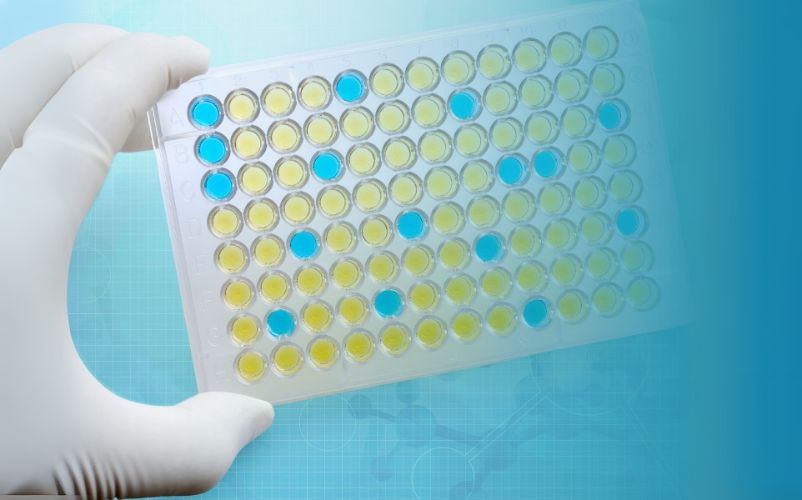How do the rapid testing methods LumiMAT and RiboNAT differ from traditional sterility and pyrogen testing?
Microorganisms, including bacteria and fungi, are the usual source of pyrogens — substances known to induce fever and cause various health issues. The introduction of these substances into the bloodstream can result in a range of severe reactions within the individual, with the potential for fatal outcomes including, but not limited to, septic shock and death.
The development of advanced pyrogen and sterility testing methodologies has enabled the detection of pyrogens at their earliest stages, for instance, during the manufacturing or packaging processes of pharmaceutical drugs and medical devices. These tests are [1,2]:
- Pyrogen testing
- Rabbit Pyrogen Test (RPT)
- Bacterial Endotoxin Test (BET), also known as the Limulus Amebocyte Lysate test (LAL)
- Monocyte Activation Test (MAT)
- Sterility testing of live therapeutics
- Nucleic Acid Amplification Tests (NAATs)
- Direct inoculation method
- Membrane filtration method
LumiMAT™: The Rapid Reliable Alternative
LumiMAT™, a cutting-edge Monocyte Activation Test (MAT), serves as a highly sensitive and effective method for the detection of pyrogens. Because the MAT method, an animal-free test, offers efficient detection of both endotoxin and non-endotoxin pyrogens, it is a more effective replacement for the RPT and the LAL assay in pyrogen testing.
For commercial purposes, most conventional kits available use Peripheral Blood Mononuclear Cells (PBMCs) in conjunction with Enzyme-Linked Immunosorbent Assays (ELISA). In preparation for testing, cryopreserved pooled PBMCs are co-cultured overnight with a test substance for 19–22 hours in a humidified 37°C incubator with 5% CO₂ atmosphere. The extent of IL-6 production serves as the primary indicator for assessing the experimental results [3].
LumiMAT™ detects both endotoxin and non-endotoxin pyrogens via an NF-κB reporter gene assay. Compared to ELISA, the NF-κB reporter gene assay is easier to handle, significantly faster (eliminating the IL-6 release wait), and offers distinct advantages. In contrast to PBMC, lot-to-lot variation was not observed. The LumiMAT™ test, completed in five hours, marks a major improvement over the two-day conventional process and its streamlined method also enhances accuracy.
RiboNAT™: Faster, More Sensitive RNA-Based Methods
The safety of Advanced Therapeutic Medicinal Products (ATMP) before patient infusion hinges on sterility testing, as terminal sterilization is not an option for live therapeutics [1].
Sterility tests currently depend on observing microbial growth, a process that takes at least 14 days to yield conclusive results. Meeting the deadline is challenging for medications needing immediate use and rapid infusion, especially those with short shelf lives, often given before full testing. This reduces usable time and increases release testing costs [4].
Real-time amplification monitoring systems represent a major recent advance in amplification technology, offering immediate feedback and control. The development of real-time PCR has provided researchers and diagnostic laboratories with a powerful new toolset. Applications range from disease diagnosis and species identification to precise gene expression quantification, SNP detection, and tracking infection levels during treatment [5].
Fujifilm Wako's RiboNAT™ sterility test represents a major leap forward in sterility testing. This development centers on amplifying RNA molecules, a crucial step in various molecular biology methods. RNA amplification provides significantly improved sensitivity in detecting microbial contamination compared to traditional culture techniques, leading to quicker problem identification.
Conclusion
The rapid testing techniques developed by Fujifilm Wako are not only faster than traditional methods, but also overcome many of their disadvantages, resulting in improved efficiency and accuracy.
References:
- Gebo, J.E.T. & Lau, A.F. (2020). Sterility Testing for Cellular Therapies: What Is the Role of the Clinical Microbiology Laboratory? J Clin Microbiol, 58(7): e01492-e01519. doi:10.1128/JCM.01492-19
- Perdomo-Morales, R. et al. (2011). Monocyte activation test (MAT) reliably detects pyrogens in parenteral formulations of human serum albumin. Altex, 28(3): 227-235. doi:10.14573/altex.2011.3.227
- Solati, S., Zhang, T. & Timman, S. (2022). The monocyte activation test detects potentiated cytokine release resulting from the synergistic effect of endotoxin and non-endotoxin pyrogens. Innate Immun, 28(3-4): 130-137. doi:10.1177/17534259221097948
- Eagle Analytical Services (2018). Suitability of ScanRDI as a Rapid Sterility Testing Method. Available online at: https://eagleanalytical.com/wp-content/uploads/2019/04/ScanRDI-_Suitability-of-ScanRDI-as-a-Rapid-Sterility-Testing-Method.pdf
- Monis, P.T. & Giglio, S. (2006). Nucleic acid amplification-based techniques for pathogen detection and identification. Infect Genet Evol, 6(1): 2-12. doi:10.1016/j.meegid.2005.08.004



